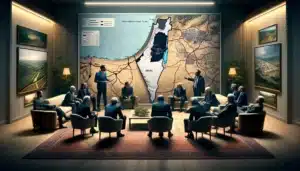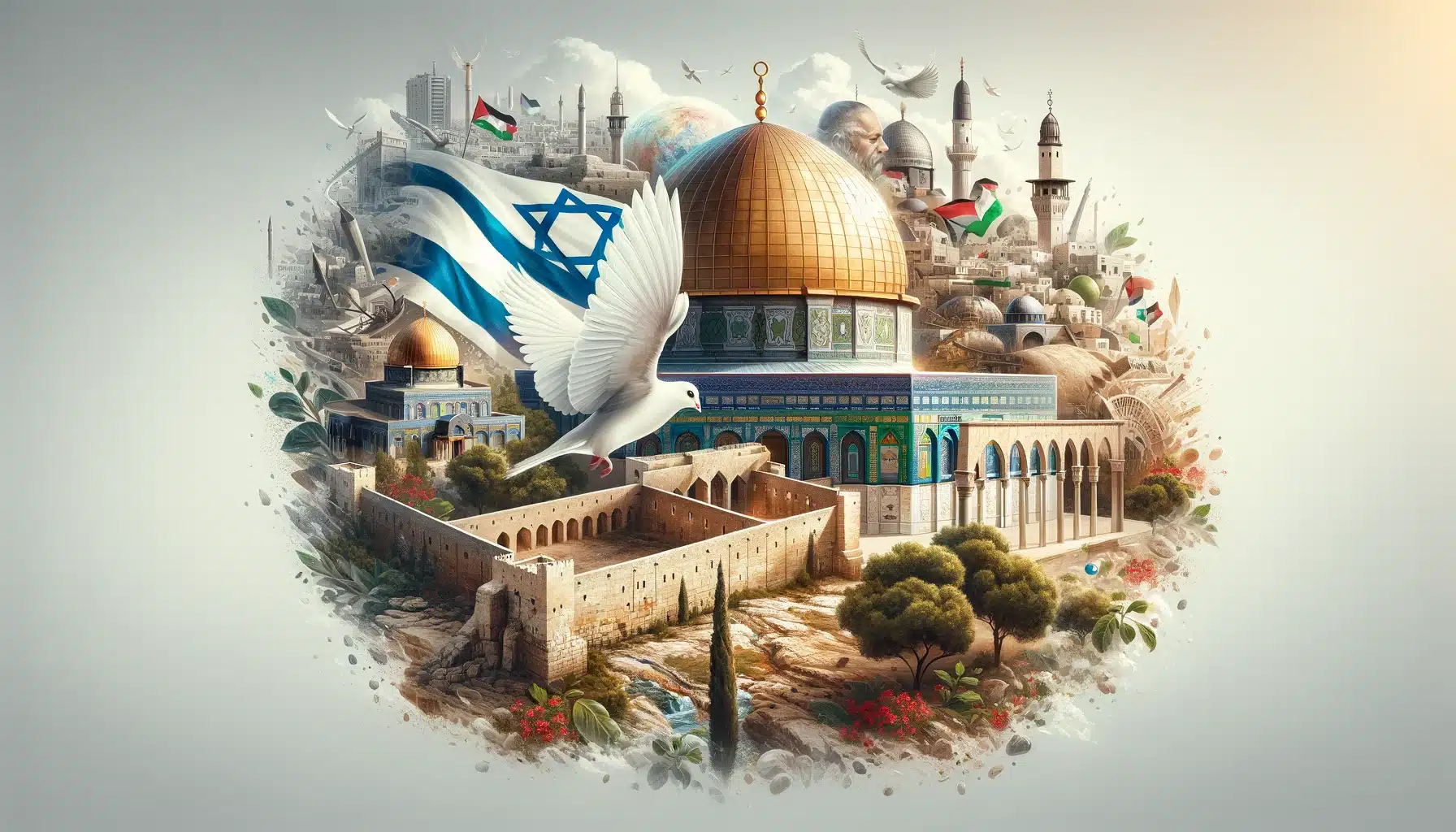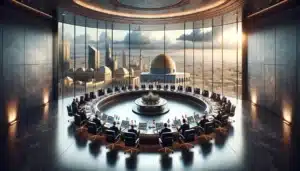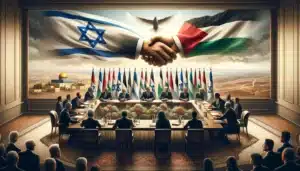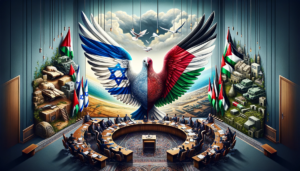Introduction to the Israeli-Palestinian Conflict
The Israeli-Palestinian conflict, a decades-long struggle with deep historical roots, continues to affect the Middle East’s geopolitical landscape profoundly. Since the 1948 Arab-Israeli War, the conflict has undergone numerous evolutions, marked by wars, peace efforts, and periods of intense violence. The year 2024 has not been an exception, witnessing escalations that pose significant questions about the future of peace in the region. These developments have not only jeopardized regional stability but also highlighted the urgent need for a sustainable resolution.
Key Events in 2024
The conflict in 2024 has seen several critical events that have exacerbated tensions:
- A series of violent incidents in January, including the shooting of a Palestinian-American teenager by Israeli forces and a car-ramming attack in Ra’anana.
- The UNRWA faced a major controversy over allegations of staff members’ involvement with Hamas, leading to a significant international response.
These incidents reflect the ongoing volatility within the region, underscoring the complexities of achieving peace.
Israeli-Palestinian Conflict: Current Political Dynamics
The political landscape in 2024 is characterized by Israel’s far-right government policies and Palestinian political fragmentation, both of which have significant implications for the conflict.
Israeli Government’s Stance
Under Prime Minister Benjamin Netanyahu, Israel has seen a shift toward far-right policies, including the expansion of settlements in the occupied West Bank. This move has further strained relations with the Palestinians and drawn international criticism, complicating the peace process.
Palestinian Authority and Hamas: Diverging Paths
The Palestinian leadership remains divided, with the Palestinian Authority controlling the West Bank and Hamas governing Gaza. This division hampers efforts toward a unified approach to peace and exacerbates the humanitarian crisis in Gaza.
Israeli-Palestinian Conflict: Humanitarian Crisis in Gaza
The humanitarian situation in Gaza has deteriorated, largely due to Israeli blockades which have restricted the entry of essential goods and services. The Oslo Accords from 1993 to 2024 have failed to bring lasting peace or improve the living conditions for Gaza’s residents, highlighting the need for renewed international focus on the crisis.
International Responses to the Crisis
The international community’s reaction to the humanitarian crisis in Gaza and the broader conflict has varied, with calls for both sides to return to negotiation and for Israel to ease restrictions on Gaza.
Societal Impacts and Public Sentiment the Israeli-Palestinian Conflict
The Israeli-Palestinian conflict has left indelible marks on societies’ divisions it engulfs. In 2024, these impacts are more pronounced than ever, affecting various facets of life.
- Psychological Toll: Ongoing violence and uncertainty have contributed to widespread psychological distress among both Israelis and Palestinians.
- Economic Strain: The conflict continues to strain economic activities, impacting livelihoods and leading to heightened poverty levels, especially in Palestinian territories.
- Cultural and Social Divides: Deep-seated mistrust and hostility pervade cultural and social interactions, with each side nurturing narratives that often demonize the other.
Voices of Moderation vs. Extremism
In this challenging landscape, the battle between moderation and extremism shapes public sentiment:
- Moderates: Advocates for peace and diplomacy, including groups that support initiatives like the two-state solution, strive to find common ground.
- Extremists: On both sides, there are elements that reject compromise, seeing it as a betrayal of their fundamental principles and goals.
Future Prospects and International Involvement in Israeli-Palestinian Conflict
The international community’s role in the Israeli-Palestinian conflict has always been pivotal. In 2024, this involvement takes on new dimensions.
Potential for Renewed Negotiations
Despite the challenges, there are emerging opportunities for renewed peace negotiations:
- International Mediation Efforts: Countries and organizations worldwide, including the United States and the European Union, are actively seeking to mediate between the conflicting parties.
- Regional Dynamics: The evolving political landscape in the Middle East, particularly following the Abraham Accords in 2024, offers new contexts for negotiation.
As 2024 unfolds, the Israeli-Palestinian conflict continues to pose significant challenges to peace in the Middle East. While the road to peace appears fraught with complexities, the combination of internal moderation, international involvement, and evolving regional dynamics could pave the way for renewed dialogue. The situation demands an informed and nuanced understanding, underscored by the need for a sustainable resolution that can ensure long-term peace and stability in the region.
In conclusion, the quest for peace in the Israeli-Palestinian conflict remains a complex and evolving journey. The coming months and years will be crucial in determining whether the conflict can find a path to peace or if it will continue on its current trajectory. For continued updates and in-depth analysis, readers can explore Geopolitics Journal’s comprehensive coverage on this and related topics.
Analyzing the Humanitarian Impact in Gaza
The humanitarian crisis in Gaza has been a focal point of the conflict. Let’s examine the data to understand the severity of the situation.
Table: Humanitarian Crisis in Gaza – Key Indicators
|
Indicator
|
2023 Statistics
|
2024 Projections
|
|
Electricity Availability
|
4 hours/day
|
3 hours/day
|
|
Unemployment Rate
|
45%
|
49%
|
|
Access to Clean Water
|
10% of population
|
9% of population
|
|
Average Monthly Imports
|
500 truckloads
|
450 truckloads
|
|
Medical Supply Shortages
|
Severe
|
Critical
|
Source: UN Reports on Gaza, 2024
This table highlights the worsening conditions in Gaza, underscoring the urgent need for international humanitarian intervention.
The Role of International Actors in the Israeli-Palestinian Conflict
International involvement has been key in mediating and providing aid. The following table breaks down the contributions and actions of various international entities.
Table: International Involvement in the Israeli-Palestinian Conflict
|
Entity
|
Type of Involvement
|
Impact on Conflict Resolution
|
|
United Nations
|
Peacekeeping, Humanitarian Aid
|
Moderate
|
|
European Union
|
Economic Sanctions, Diplomacy
|
Significant
|
|
United States
|
Political Mediation, Military Aid
|
Substantial
|
|
Arab League
|
Political Support for Palestinians
|
Moderate
|
Source: International Relations Analyses, 2024
This table provides a snapshot of how different international actors are contributing to conflict resolution efforts.
Future Projections and Peace Initiatives
Looking forward, understanding the potential for peace initiatives is crucial. The next table outlines the likelihood of various peace efforts and their potential impact.
Table: Prospects for Peace Initiatives in 2024
|
Initiative
|
Likelihood of Success
|
Potential Impact on Peace
|
|
Two-State Solution
|
Low
|
High
|
|
International Peace Summit
|
Moderate
|
Moderate
|
|
Regional Cooperation Agreements
|
High
|
Significant
|
Source: Geopolitical Forecasting Reports, 2024
This table indicates that while traditional solutions like the two-state model face challenges, new regional agreements might offer significant opportunities for peace.
Conclusion
The Israeli-Palestinian conflict in 2024 is marked by a blend of historical challenges and emerging opportunities. As we have seen through various data representations, the situation is dynamic, with varying levels of humanitarian need, international involvement, and potential for peace initiatives. It’s a complex narrative that continues to evolve, requiring ongoing attention and adaptive strategies.
For continued comprehensive coverage on this topic, readers are encouraged to explore Geopolitics Journal’s insightful articles and analyses, including those on Israeli settlement expansion, the 1948 Arab-Israeli War, the Abraham Accords in 2024, the viability of the two-state solution today, and the evolution of the Oslo Accords from 1993 to 2024.
